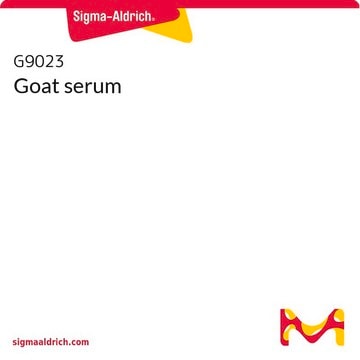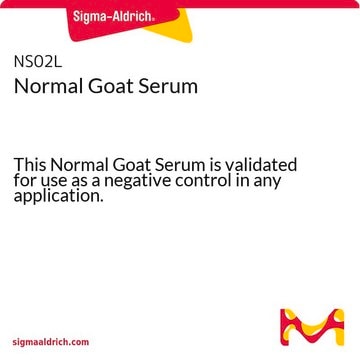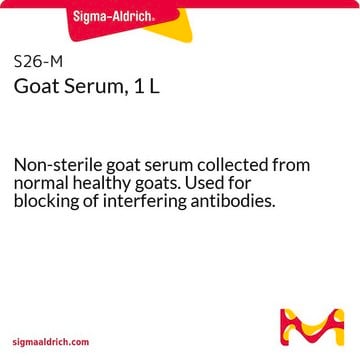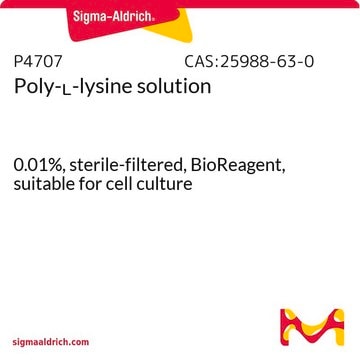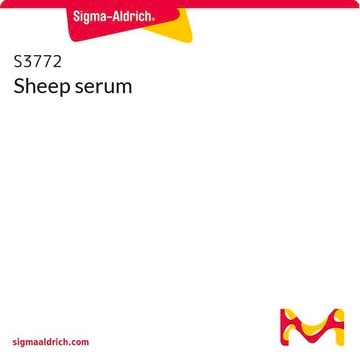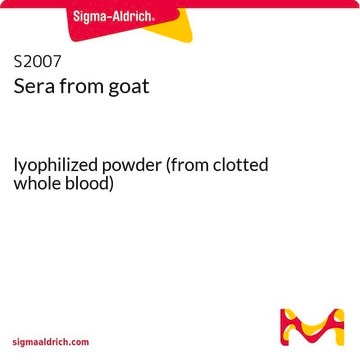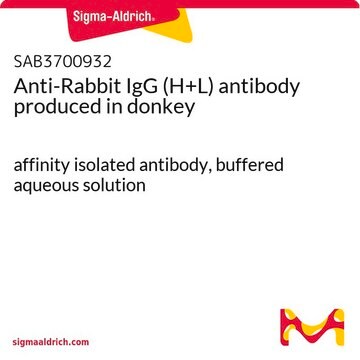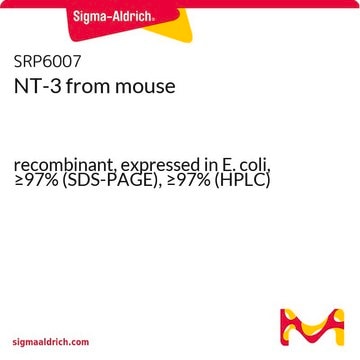A protocol is not associated with this product. A preservative is added to this serum, making it unsuitable for cell culture. However, in blocking applications, it is typically used at a concentration of 5% - 20%. It may be helpful to view the 'Peer Reviewed Papers' and 'Protocols and Articles' section of the product detail page.
D9663
Suero de burro
Sinónimos:
Suero, Serum from donkey
Seleccione un Tamaño
86,20 €
Seleccione un Tamaño
About This Item
86,20 €
Productos recomendados
origen biológico
donkey
Nivel de calidad
esterilidad
non-sterile
contiene
preservative
aplicaciones
research pathology
Condiciones de envío
dry ice
temp. de almacenamiento
−20°C
¿Está buscando productos similares? Visita Guía de comparación de productos
Descripción general
Aplicación
- como componente del tampón de bloqueo para inmunofluorescencia[2]
- en disolución salina tamponada con fosfato (PBS) como bloqueante[2]
- como bloqueante en la inmunocitoquímica y la inmunohistoquímica congelada[3]
- para evitar la unión inespecífica en la inmunohistoquímica de la parvalbúmina[4]
Cláusula de descargo de responsabilidad
Producto relacionado
Palabra de señalización
Warning
Frases de peligro
Consejos de prudencia
Clasificaciones de peligro
Aquatic Chronic 2 - Eye Irrit. 2 - Skin Irrit. 2 - Skin Sens. 1
Código de clase de almacenamiento
12 - Non Combustible Liquids
Clase de riesgo para el agua (WGK)
WGK 3
Punto de inflamabilidad (°F)
Not applicable
Punto de inflamabilidad (°C)
Not applicable
Elija entre una de las versiones más recientes:
Certificados de análisis (COA)
¿No ve la versión correcta?
Si necesita una versión concreta, puede buscar un certificado específico por el número de lote.
¿Ya tiene este producto?
Encuentre la documentación para los productos que ha comprado recientemente en la Biblioteca de documentos.
Los clientes también vieron
Protocolos
Cultivate ReNcell® human neural stem cells in 3D hydrogels for high-throughput screening using the TrueGel3D® HTS Hydrogel Plate with this protocol.
TrueGel3D® Hydrogel Plate protocol guides high-throughput culture of human adipose MSCs for screening applications.
-
where can I find the protocol to reconstitute this donkey serum
1 respuesta-
¿Le ha resultado útil?
-
-
Is heat inactivation required for D9663 in immunofluorescence (IF)? I found information stating that it is not necessary for immunohistochemistry (IHC). If this applies to IF as well, what is the reason behind it?
1 respuesta-
Donkey serum does not require heat inactivation for immunofluorescence. It is important to note that this is not a sterile product. While the lab may have routinely heat inactivated their serums for immunofluorescence, this is likely for worker safety rather than a specific requirement for performing immunofluorescence.
¿Le ha resultado útil?
-
-
Does donkey serum D9663-10ML require heat inactivation prior to immunohistochemical assay?
1 respuesta-
There is no need to heat inactivate donkey serum for blocking purposes.
¿Le ha resultado útil?
-
Filtros activos
Nuestro equipo de científicos tiene experiencia en todas las áreas de investigación: Ciencias de la vida, Ciencia de los materiales, Síntesis química, Cromatografía, Analítica y muchas otras.
Póngase en contacto con el Servicio técnico
